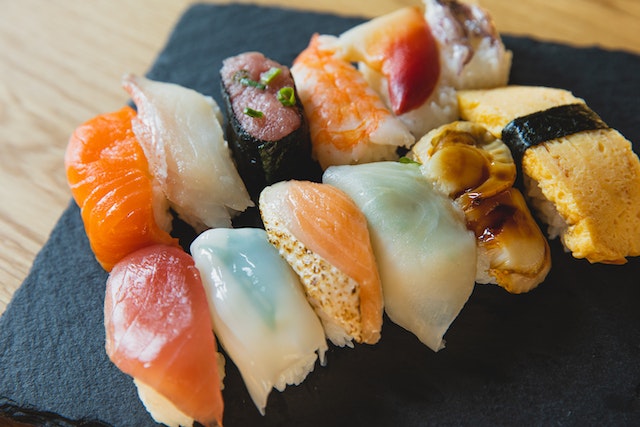Is Asian food healthy? Over the years, Asian diets have become increasingly popular as a weight loss and health improvement strategy. The diet is based on the customary meals and preparation techniques of Asian countries including China, Japan, and Korea. These cuisines are best known for their nutrient-dense foods and emphasis on fresh ingredients, lean proteins, and plant-based meals. In this article, we will explore the different diets, nutrition, and meal plans that are associated with the Asian diet for weight loss.
Healthy Asian Diet Plans
Japanese Diet
 Japanese diets are known for their fish, soy, and vegetable content. The food is rich in fiber, lean protein, and healthy fats. Fish is an important part of the Japanese diet, and it is usually consumed at least once a day. The fish is typically grilled or steamed, and it is served with a side of vegetables.
Japanese diets are known for their fish, soy, and vegetable content. The food is rich in fiber, lean protein, and healthy fats. Fish is an important part of the Japanese diet, and it is usually consumed at least once a day. The fish is typically grilled or steamed, and it is served with a side of vegetables.
Another important component of the Japanese diet is soy-based cuisine. Tofu, edamame, and miso soup are all examples of soy-based foods that are commonly consumed in Japan. Adding these foods to your weight loss diet is a great idea because they are rich in protein and low in calories.
Korean Diet
Korean diet is mainly comprised of rice, vegetables, and fish and chicken as lean protein sources. One of the most popular dishes in Korea is kimchi, it’s a fermented vegetable dish that is known for its probiotic properties. Kimchi is often served as a side dish, and it is a great way to add flavor and nutrition to any meal.
Another popular Korean dish is bibimbap, which is a bowl of rice topped with vegetables, protein, and a spicy sauce. If you are looking for a calorie-efficient and filling meal, this dish is a great option.
Chinese Diet
Chinese diet consists of rice, vegetables, and lean protein sources such as chicken, fish, and tofu such as. One of the most important aspects of the Chinese diet is the emphasis on balance. Meals are typically made up of a combination of different foods, including vegetables, grains, and protein.
One of the most popular Chinese dishes is stir-fry, which is a quick and easy way to cook a variety of vegetables and protein sources. The dish is typically served with a side of rice, making it a filling and satisfying meal.
Foods in Asian Cuisine
Rice
 In many Asian diets, rice is the main component. Rice is a great source of carbohydrates that can provide you with energy, helping you feel full all day long. Several Asian diets depend heavily on rice. Due to its high fiber content and other nutritional value, brown rice is a particularly healthy choice.
In many Asian diets, rice is the main component. Rice is a great source of carbohydrates that can provide you with energy, helping you feel full all day long. Several Asian diets depend heavily on rice. Due to its high fiber content and other nutritional value, brown rice is a particularly healthy choice.
Vegetables
As a great source of vitamins, minerals, and fiber, vegetables are crucial to the Asian diet. Leafy greens such as kale and spinach are particularly nutrient-dense and can help to promote weight loss. Other vegetables that are commonly used in Asian cuisine include broccoli, carrots, mushrooms, and peppers. These vegetables can be cooked in a variety of ways, including stir-fry and steaming, making them a versatile and easy addition to any meal.
Lean Protein
Lean protein is an essential component of the Asian diet, as it provides energy and satiation, which can help you lose weight. Fish, chicken, and tofu are all popular sources of lean protein in Asian cuisine. These foods are typically cooked in simple ways, such as grilling or steaming, to help preserve their nutritional value.
Sample diet plan based on the Asian diet for weight loss
Breakfast:
- Miso soup with tofu and scallions
- Steamed brown rice
- Grilled salmon or a boiled egg
- Steamed or stir-fried leafy greens (such as bok choy, spinach, or kale)
Mid-morning snack:
- A handful of almonds or cashews
Lunch:
- Chicken or tofu stir-fry with vegetables (such as broccoli, carrots, and bell peppers)
- Brown rice or quinoa
- Kimchi or other fermented vegetables
Afternoon snack:
- Sliced cucumber or celery sticks with hummus or another healthy dip
Dinner:
- Grilled fish (such as salmon, cod, or tilapia) or lean protein (such as chicken or tofu)
- Steamed or stir-fried vegetables (such as snow peas, mushrooms, and carrots)
- A side of brown rice or quinoa
Dessert:
- Fresh fruit (such as mango, papaya, or pineapple)
In conclusion is important to note that this is just a sample diet plan, and it is not intended to be a one-size-fits-all solution or a Skinny Asian Diet. As the Asian diet emphasizes fresh, whole foods and moderate portions, remember to adjust the quantities to your needs.
It is generally recommended that you consume a diet high in fiber, lean protein, and healthy fats. In addition, you should limit your intake of processed foods and sugary drinks. Stay hydrated and support healthy digestion by drinking plenty of water throughout the day.
Also, don’t forget to engage in regular physical activity along with following a healthy diet. Get at least 30 minutes of moderate-intensity exercise most days of the week (like brisk walking, cycling, or swimming). This can help to further support weight loss and overall health.
In general, the Asian diet promotes weight loss and improves overall health for those who wish to lose weight. By incorporating nutrient-dense foods such as whole grains, vegetables, and lean protein sources, you can create a healthy, balanced diet that supports your goals.
If you are considering or expecting to undergo a bariatric weight loss procedure, it is crucial to consult with a medical professional. Depending on the specific procedure you are planning, there may be important dietary restrictions to be mindful of both before and after the surgery. Seeking expert guidance will ensure you are well informed and prepared for a successful journey toward your weight loss goals.







